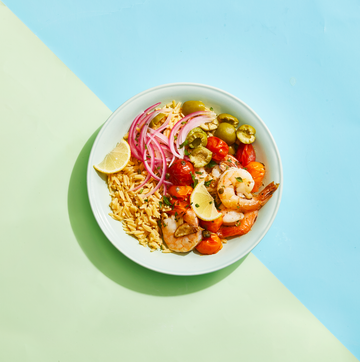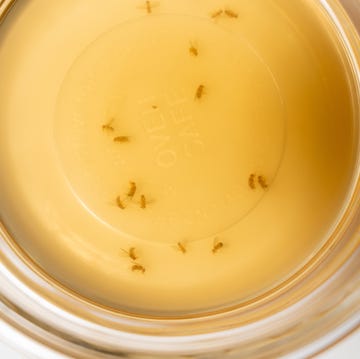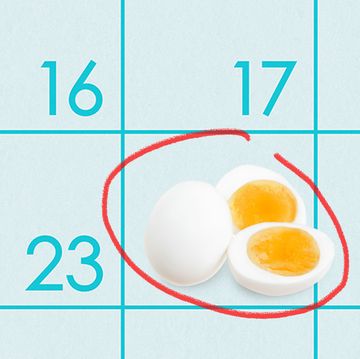1Start with fresh picks.
 Wang Yukun//Getty Images
Wang Yukun//Getty ImagesSet yourself up for success by getting your hands on the freshest produce possible. Ideally, that’s from your garden or farmers market but if that’s not feasible, shop at a good grocery store that sources mostly from local farms, rather than produce shipped from across the country or beyond. The time it takes to travel eats into the freshness.
In the store, carefully inspect before you buy. There may be bruising on apples, yellowing leaves on kale or a hidden moldy raspberry in the container that you may miss at first glance. If something has already been languishing in the produce bin, none of these hacks will bring it back to life, Lazarus-style.
2Separate ethylene emitters.
 amriphoto//Getty Images
amriphoto//Getty ImagesHave you ever wondered why most fridges have two crisper drawers? Some people use it to sort fruits and vegetables or low- vs. high-humidity produce. But the best way to optimize the two-drawer system is to separate produce that emits ethylene from ones that are sensitive to this natural plant gas that accelerates ripening. (It’s the science behind how to ripen an avocado quickly: Placing it in a paper bag will keep it trapped with the ethylene it releases.)
Ethylene emitters:
- Apples
- Avocados
- Bananas
- Cantaloupe
- Kiwi
- Peaches
- Pears
- Peppers
- Tomatoes
Ethylene sensitive:
- Apples
- Asparagus
- Avocados
- Bananas
- Cucumber
- Eggplant
- Grapes
- Kiwi
- Lettuce
- Leafy greens
- Lemons
- Limes
- Mangos
- Melons
- Peaches
- Pears
- Peppers
You’ll notice that some produce (like apples, bananas, kiwi, peaches, pears, peppers and avocados) both release and are sensitive to ethylene — store them separately from other ethylene emitters and avoid keeping them in sealed bags or containers. For longer freshness, store sensitive items in the crisper drawer with produce that is not sensitive to ethylene, such as:
- Blueberries
- Cherries
- Beans (Snap)
- Garlic
- Grapefruit
- Oranges
- Pineapple
- Potatoes
- Raspberries
- Strawberries
- Yucca
Advertisement - Continue Reading Below
3Store produce unwashed.
 pinstock//Getty Images
pinstock//Getty ImagesSome produce, like cucumbers and apples, have a waxy coating (either natural or manufactured) that helps them retain moisture. Washing the wax away and then storing the produce will accelerate the eventual shriveling.
Washing before storing also introduces moisture, which is the enemy of longevity for certain produce, such as berries, lettuce, potatoes and onions. Especially in the case of berries, the added moisture will help mold spread and make it rot faster.
RELATED: The Best Produce Delivery Boxes, Tried and Tested
4Wrap asparagus in damp paper towels.
 iuliia_n//Getty Images
iuliia_n//Getty ImagesCertain vegetables crave hydration. Asparagus is definitely at the top of the list. Just wet some paper towels, wring out the excess water then wrap it around the spears and store in a plastic bag in the fridge. Think of it as a sheet mask for produce.
Advertisement - Continue Reading Below
5Create an asparagus vase for scallions.
 ChristopherBernard//Getty Images
ChristopherBernard//Getty ImagesScallions just want to be treated like flowers. They do best when stored root-side down in a glass or jar, with just enough water to cover the roots. Make sure to trim any damaged ends before storing and to change the water every couple of days to prevent bacteria growth.
6Swaddle lettuce in dry paper towels.
 Filippo Arteconi//Getty Images
Filippo Arteconi//Getty ImagesTo keep lettuce, spinach and other leafy greens from wilting and going soggy in the fridge, loosely wrap them in dry paper towels and store them in a plastic bag.
Advertisement - Continue Reading Below
7Store tomatoes stem side down.
 Oscar Wong//Getty Images
Oscar Wong//Getty ImagesThe stem is where tomatoes lose their moisture so storing them at room temperature (not in the refrigerator) stem side down will help keep them plump and juicy longer. If you’re feeling extra, you can even put a piece of Scotch tape on the stem area to slow down the moisture loss even more.
8Wrap banana stems.
 Vera_Petrunina//Getty Images
Vera_Petrunina//Getty ImagesSpeaking of tape, you can slow down the ripening of bananas by wrapping each individual stem with tape, foil or plastic wrap. This reduces their release of ethylene, which speeds up the ripening process.
RELATED: A List of the Healthiest Fruits You Can Eat
Advertisement - Continue Reading Below
9Store mushrooms in paper bags.
 Dani Bazelkova//Getty Images
Dani Bazelkova//Getty ImagesJust like cats, these fungi love being inside paper bags, where it’s dark and dry. Mushrooms are naturally high in moisture, which is great for sauteing — and, sadly, for spoiling quicker in the refrigerator. Be sure to remove your ‘shrooms from any original plastic packaging then store them in a clean paper bag in the low-moisture drawer in the fridge.
10Remove greens from carrots.
 Marc Romanelli//Getty Images
Marc Romanelli//Getty ImagesCarrots with the greens still attached are usually fresher than those without; however, keeping them intact during storage makes the root ends spoil more quickly. Chop or tear off the greens. Don't be tempted to toss them, though. Carrot tops can be used like herbs to make chimichurri or a carrot top pesto!
Advertisement - Continue Reading Below
11Wrap celery in foil.
 NTCo//Getty Images
NTCo//Getty ImagesIt may seem odd to wrap vegetables in foil but it has a dual function: It helps retain the moisture that keeps celery crunchy without being so airtight that it traps in the ethylene that makes the stalks go limp. Just wrap the entire bunch in a sheet of foil but don’t crimp or seal the ends.
12Separate onions from potatoes.
 TopPhotoImages//Getty Images
TopPhotoImages//Getty ImagesOnions and potatoes are similar in that they last longest in a cool, dark place with plenty of airflow, like a wicker basket — but just not together. Why? Again, the culprit is ethylene. Onions produce this gas, which makes potatoes sprout and spoil more quickly.
Advertisement - Continue Reading Below
13Store garlic in a ceramic garlic keeper.
 edoneil//Getty Images
edoneil//Getty ImagesThe most common reason why garlic sprouts, creating that unpleasant, bitter green strip in the clove, is because it’s exposed to too much light, heat and moisture. Keeping garlic in a ceramic garlic keeper protects them from those elements. They come in different styles, from minimalist to more ornate, but the common theme is that they have air holes to help keep the garlic dry. For a no-cost alternative that’s almost as good, you can just keep the garlic loose on the counter away from heat and light.
RELATED: The Right Way to Store Garlic
14Soak berries in vinegar solution.
 TontoRuga//Getty Images
TontoRuga//Getty ImagesWe found that storing berries in a single layer separated by paper towels helps lengthen their life span but if you want to go the extra mile, you can try the vinegar method. This involves briefly soaking berries in 1 cup of any vinegar diluted with 3 cups of water. Give them a good rinse in plain water to get rid of the vinegar flavor then drain and thoroughly dry them before storing them between paper towels in the fridge.
Advertisement - Continue Reading Below
15Keep basil at room temperature.
 deepblue4you//Getty Images
deepblue4you//Getty ImagesBasil grows and thrives in the Mediterranean sun so the refrigerator feels like the Arctic for this delicate herb. It’s best kept like flowers in a vase with some water in a jar or glass. The same holds true for other tender herbs, like mint and cilantro. As with flowers, be sure to change out the water to keep it clean and bacteria-free.
RELATED: The Right Way to Store Fresh Herbs
16Refrigerate avocados.
 Ake Ngiamsanguan//Getty Images
Ake Ngiamsanguan//Getty ImagesSometimes the avocado is ready for you but you’re not ready for it. Instead of letting it go brown and black inside, just pop that ‘cado in the fridge. Store it away from the other ethylene producers, which will only speed up its ripening.
Advertisement - Continue Reading Below
17Separate cucumbers with paper towels.
 Vladdeep//Getty Images
Vladdeep//Getty ImagesCucumbers seem to go from crisp to mushy almost overnight. To help them from going limp, remove cukes from their original packaging then separate them with paper towels to absorb excess moisture.
Finding it hard to keep all the rules straight? Refer to this handy chart:
Advertisement - Continue Reading Below
Readers Also Read
Advertisement - Continue Reading Below
Advertisement - Continue Reading Below






























